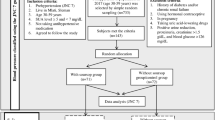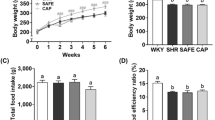Abstract
To compare the antihypertensive effectiveness of sour tea (ST; Hibiscus sabdariffa) with black tea (BT) infusion in diabetic patients, this double-blind randomized controlled trial was carried out. Sixty diabetic patients with mild hypertension, without taking antihypertensive or antihyperlipidaemic medicines, were recruited in the study. The patients were randomly allocated to the ST and BT groups and instructed to drink ST and BT infusions two times a day for 1 month. Their blood pressure (BP) was measured on days 0, 15 and 30 of the study. The mean of systolic BP (SBP) in the ST group decreased from 134.4±11.8 mm Hg at the beginning of the study to 112.7±5.7 mm Hg after 1 month (P-value <0.001), whereas this measure changed from 118.6±14.9 to 127.3±8.7 mm Hg (P-value=0.002) in the BT group during the same period. The intervention had no statistically significant effect on the mean of diastolic BP (DBP) in either the ST or BT group. The mean pulse pressure (PP) of the patients in the ST group decreased from 52.2±12.2 to 34.5±9.3 mm Hg (P-value <0.001) during the study, whereas in the BT group, it increased from 41.9±11.7 to 47.3±9.6 mm Hg (P-value=0.01). In conclusion, consuming ST infusion had positive effects on BP in type II diabetic patients with mild hypertension. This study supports the results of similar studies in which antihypertensive effects have been shown for ST.
This is a preview of subscription content, access via your institution
Access options
Subscribe to this journal
Receive 12 digital issues and online access to articles
$119.00 per year
only $9.92 per issue
Buy this article
- Purchase on Springer Link
- Instant access to full article PDF
Prices may be subject to local taxes which are calculated during checkout
Similar content being viewed by others
References
El-Atat F, McFarlane SI, Sowers JR . Diabetes, hypertension, and cardiovascular derangements: pathophysiology and management. Curr Hypertens Rep 2004; 6: 215–223.
Wolf-Maier K, Cooper RS, Banegas JR, Giampaoli S, Hense HW, Joffres M et al. Hypertension prevalence and blood pressure levels in 6 European countries, Canada, and the United States. JAMA 2003; 289: 2363–2369.
Kearney PM, Whelton M, Reynolds K, Whelton PK, He J . Worldwide prevalence of hypertension: a systematic review. J Hypertens 2004; 22: 11–19.
Kearney PM, Whelton M, Reynolds K, Muntner P, Whelton PK, He J . Global burden of hypertension: analysis of worldwide data. Lancet 2005; 365: 217–223.
Azizi F, Ghanbarian A, Madjid M, Rahmani M . Distribution of blood pressure and prevalence of hypertension in Tehran adult population: Tehran Lipid and Glucose Study (TLGS), 1999–2000. J Hum Hypertens 2002; 16: 305–312.
Bahrami H, Sadatsafavi M, Pourshams A, Kamangar F, Nouraei M, Semnani S et al. Obesity and hypertension in an Iranian cohort study; Iranian women experience higher rates of obesity and hypertension than American women. BMC Public Health 2006; 6: 158.
Sadeghi M, Roohafza HR, Kelishadi R . Blood pressure and associated cardiovascular risk factors in Iran: Isfahan Healthy Heart Programme. Med J Malaysia 2004; 59: 460–467.
Singh RB, Suh IL, Singh VP, Chaithiraphan S, Laothavorn P, Sy RG et al. Hypertension and stroke in Asia: prevalence, control and strategies in developing countries for prevention. J Hum Hypertens 2000; 14: 749–763.
Ali BH, Al WN, Blunden G . Phytochemical, pharmacological and toxicological aspects of Hibiscus sabdariffa L.: a review. Phytother Res 2005; 19: 369–375.
Hirunpanich V, Utaipat A, Morales NP, Bunyapraphatsara N, Sato H, Herunsalee A et al. Antioxidant effects of aqueous extracts from dried calyx of Hibiscus sabdariffa Linn. (Roselle) in vitro using rat low-density lipoprotein (LDL). Biol Pharm Bull 2005; 28: 481–484.
Adegunloye BJ, Omoniyi JO, Owolabi OA, Ajagbonna OP, Sofola OA, Coker HA . Mechanisms of the blood pressure lowering effect of the calyx extract of Hibiscus sabdariffa in rats. Afr J Med Med Sci 1996; 25: 235–238.
Ali MB, Salih WM, Mohamed AH, Homeida AM . Investigation of the antispasmodic potential of Hibiscus sabdariffa calyces. J Ethnopharmacol 1991; 31: 249–257.
Odigie IP, Ettarh RR, Adigun SA . Chronic administration of aqueous extract of Hibiscus sabdariffa attenuates hypertension and reverses cardiac hypertrophy in 2K-1C hypertensive rats. J Ethnopharmacol 2003; 86: 181–185.
Onyenekwe PC, Ajani EO, Ameh DA, Gamaniel KS . Antihypertensive effect of roselle (Hibiscus sabdariffa) calyx infusion in spontaneously hypertensive rats and a comparison of its toxicity with that in Wistar rats. Cell Biochem Funct 1999; 17: 199–206.
Chen CC, Chou F, Ho WL, Lin WL, Wang CP, Kao S et al. Inhibitory effects of Hibiscus sabdariffa L extract on low-density lipoprotein oxidation and anti-hyperlipidemia in fructose-fed and cholesterol-fed rats. J Sci food and agri 2004; 84: 1989–1996.
Herrera-Arellano A, Flores-Romero S, Chavez-Soto MA, Tortoriello J . Effectiveness and tolerability of a standardized extract from Hibiscus sabdariffa in patients with mild to moderate hypertension: a controlled and randomized clinical trial. Phytomedicine 2004; 11: 375–382.
Lin TL, Lin HH, Chen CC, Lin MC, Chou MC, Wang CJ . Hibiscus sabdariffa extract reduces serum cholesterol in men and women. Nutr Res 2007; 27: 140–145.
Herrera-Arellano A, Miranda-Sanchez J, vila-Castro P, Herrera-Alvarez S, Jiménez-Ferrer JE, Zamilpa A et al. Clinical effects produced by a standardized herbal medicinal product of Hibiscus sabdariffa on patients with hypertension. A randomized, double-blind, lisinopril-controlled clinical trial. Planta Med 2007; 73: 6–12.
Chen CC, Hsu JD, Wang SF, Chiang HC, Yang MY, Kao ES et al. Hibiscus sabdariffa extract inhibits the development of atherosclerosis in cholesterol-fed rabbits. J Agric Food Chem 2003; 51: 5472–5477.
Haji Faraji M, Haji Tarkhani A . The effect of sour tea (Hibiscus sabdariffa) on essential hypertension. J Ethnopharmacol 1999; 65: 231–236.
Ajay M, Chai HJ, Mustafa AM, Gilani AH, Mustafa MR . Mechanisms of the anti-hypertensive effect of Hibiscus sabdariffa L. calyces. J Ethnopharmacol 2007; 109: 388–393.
Esteghamati A, Gouya MM, Abbasi M, Delavari A, Alikhani S, Alaedini F et al. Prevalence of diabetes and impaired fasting glucose in the adult population of Iran: national survey of risk factors for non-communicable diseases of Iran. Diabetes Care 2008; 31: 96–98.
Hadaegh F, Bozorgmanesh MR, Ghasemi A, Harati H, Saadat N, Azizi F . High prevalence of undiagnosed diabetes and abnormal glucose tolerance in the Iranian urban population: Tehran lipid and glucose study. BMC Public Health 2008; 8: 176.
Janghorbani M, Amini M . Metabolic syndrome in type 2 diabetes mellitus in isfahan, iran: prevalence and risk factors. Metab Syndr Relat Disord 2007; 5: 243–254.
Anon. The sixth report of the Joint National Committee on prevention, detection, evaluation, and treatment of high blood pressure. Arch Intern Med 1997; 157: 2413–2446.
Acknowledgements
The department of Medical Research at Shahid Sadoughi University of Medical Sciences has funded this study, which is appreciated. Special thanks to the patients who participated in this study. We also appreciate the efforts of the personnel of Diabetes Research Centre, especially Dr Mojgan Solymanizadeh, who helped us in data collection, blood sampling and lab tests. We also thank Dr Mohammad Hossein Mosaddegh for reviewing and editing the final draft of this paper.
Author information
Authors and Affiliations
Corresponding author
Rights and permissions
About this article
Cite this article
Mozaffari-Khosravi, H., Jalali-Khanabadi, BA., Afkhami-Ardekani, M. et al. The effects of sour tea (Hibiscus sabdariffa) on hypertension in patients with type II diabetes. J Hum Hypertens 23, 48–54 (2009). https://doi.org/10.1038/jhh.2008.100
Received:
Revised:
Accepted:
Published:
Issue Date:
DOI: https://doi.org/10.1038/jhh.2008.100
Keywords
This article is cited by
-
Herbal Teas and their Health Benefits: A Scoping Review
Plant Foods for Human Nutrition (2019)
-
Effects of salt stress on the morphological characteristics, total phenol and total anthocyanin contents of Roselle (Hibiscus sabdariffa L.)
Plant Physiology Reports (2019)
-
Clinical efficacy of African traditional medicines in hypertension: A randomized controlled trial with Combretum micranthum and Hibiscus sabdariffa
Journal of Human Hypertension (2018)
-
Randomised, double-blind, placebo-controlled, assessment of the efficacy and safety of dietary supplements in prehypertension
Journal of Human Hypertension (2017)
-
Roselle calyces (Hibiscus sabdariffa), an alternative to the food and beverages industries: a review
Journal of Food Science and Technology (2015)



